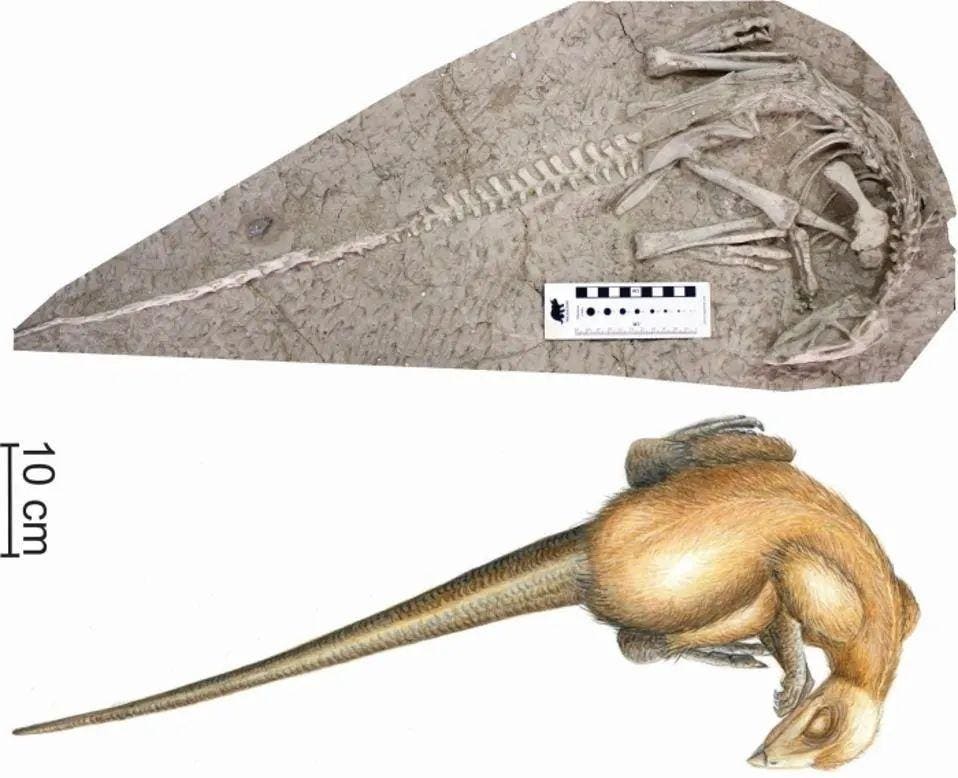A complete and articulated skeleton discovered in the Yixian Formation and now hosted at … [+]
C. Ciselet/YANG et al. 2020/PeerJ
of Yixian formationA 120- to 130-million-year-old geological formation outcropping in northeastern China’s Liaoning Province has for more than 20 years produced exceptionally well-preserved fossils of insects, plants, shells, fish, and several hundred skeletons of feathered dinosaurs.
How did they get these fossils to be so perfect? The leading hypothesis so far has been sudden burial by volcanism, perhaps like the hot ash waves from Vesuvius that buried many citizens of Pompeii over 2,000 years ago, and the Yixian deposits have been popularly called the “Chinese Pompeii.”
Previous studies have suggested that multiple volcanic events occurred in pulses over about a million years, repeatedly burying the animals and preserving their remains. But a new study completely refutes this theory, showing that the fossils date to a period of less than 93,000 years when there was no volcanic activity at all. The creatures were saved from more common events, including burrow collapses during rainy periods.
“These are probably the most important dinosaur discoveries of the last 120 years,” says study co-author Paul Olsen, a paleontologist at the Columbia School of Climate’s Lamont-Doherty Earth Observatory.
“But what has been said about their method of preservation highlights an important human bias. That is, to attribute extraordinary causes to ordinary events, ie. miracles, when we do not understand their origin. These fossils are just a snapshot of daily deaths under normal conditions over a relatively short time.”
Previous studies have suggested that dinosaurs were enveloped by lahars, fast-moving concrete-like mud that flows from volcanoes after eruptions. But lahars are extremely violent, Olsen argues, and prone to shredding anything living or dead they encounter, so this explanation doesn’t work for intact, perfectly articulated skeletons.
An alternative explanation included pyroclastic flows, fast-moving clouds of hot ash, and poisonous gases. These struck the inhabitants of Pompeii, then wrapped the bodies in protective layers of material that preserved them as they were at the moment of death. Even when the remains decayed, gaps remained in the ashes, from which investigators have made living casts. The bones are characteristically twisted in so-called pugilistic positions, doubled over excruciatingly and with limbs severely drawn as the blood boiled and the muscles crumpled in the explosive heat. Victims of modern fires show similar poses.
While there are in fact layers of volcanic ash, lava, and magma intrusions in the Yixian Formation, the remains there do not match those of the ill-fated Pompeians. For one thing, feathers, fur, and everything else would almost certainly have burned up in a pyroclastic flow. For another, dinosaurs and other animals are not in pugilistic positions; instead, many are found with their arms and tails quietly wrapped around their bodies, as if they were sleeping (a dinosaur described in 2020 was even named Changmiania liaoningensis meaning “Eternal Sleeper from Liaoning”).
Instead, the evidence points to sudden sinkhole collapses, the researchers say. The rock cores surrounding skeletonized fossils generally consist of coarse grains, but the grains immediately surrounding and within the skeletons tend to be much finer. The researchers interpret this to mean that there was enough oxygen around for a while for the bacteria or insects to at least degrade the animal’s skin and organs, and as this happened, whatever fine grains were in the surrounding material preferred to penetrate and fill the voids. ; the bones more resistant to decay remained intact. Even today, den collapses are a common cause of death for animals, so Olsen. This new theory could also explain the fossil showing an early mammal and a small dinosaur seemingly frozen in time during a fierce battle. This may have happened after the mammal invaded the dinosaur’s burrow, when the burrow collapsed, sealing the fate of both animals.
What caused the collapse remains speculation. Sedimentary features suggest that the Yixian Formation was deposited during a wet period in Earth’s history. Heavy rain could have helped destabilize the soil, Olson notes, burying sleeping dinosaurs in their burrows.
To find the fossil ages, the study’s lead author, Scott MacLennan of South Africa’s University of the Witwatersrand, analyzed tiny grains of the mineral zircon, taken from the surrounding rocks and from the fossils themselves. Within these, he measured the ratios of radioactive uranium to lead, using a new, extremely accurate method called chemical isotope dilution thermal ionization mass spectroscopy, or CA-ID-TIMS. The fossils and surrounding material are consistently dated to 125.8 million years ago, concentrated around a period of less than 93,000 years and embedded between volcanic deposits.
Olsen believes that the Yixian Formation is not unique. “It’s just that there is no other place where such an intense gathering has taken place in this type of environment,” he concludes.
Only in the eastern United States, some sites that once had Yixian-like environments could produce similar fossils. These include a rocky quarry straddling the North Carolina-Virginia border where he has found thousands of perfectly preserved insects; sites in Connecticut where small excavations have shown promise; and a former quarry in North Bergen, NJ, now nestled between a freeway and a shopping center that once produced fabulously preserved fish and reptiles.
The full study, “The extremely rapid but not catastrophic preservation of China’s Early Cretaceous 3D flattened-feathered dinosaurs,” was published in the magazine Proceedings of the National Academy of Sciencess and can be found here.
Additional materials and interviews provided by Kevin Krajick, Columbia Climate School.
